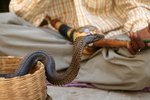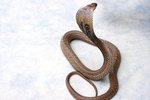
Pythons belong to the constrictor family of snakes, meaning they squeeze their prey and suffocate them rather than using poison to kill or disable them. Just because they don’t have poison doesn’t mean they can’t bite; Indian pythons have two rows of very sharp teeth angled toward the throat that can deliver a painful bite. Python molurus molurus is sometimes called the Indian rock python as well as simply the Indian python.
Constrictor Construction
Constrictors are different from other snakes because they have two lungs instead of the one common in other species. Constricting snakes, including the Indian python, have pelvic bones connected to vestigial leg bones, called spurs, that provide a clue to their past as animals that once walked on legs. The Indian python uses spurs during breeding but not for locomotion.
Natural Habitat and Habits
The Indian python comes from the forests of Nepal, Indian, Sri Lanka and Pakistan but may also be found in rocky foothills, river valleys and scrubland. The snake lives alone except during mating season and often drapes itself over branches or coils up on the ground, waiting to ambush prey. The Indian python usually lives near water in areas that offer plenty of cover.
Eating Habits
This snake typically hunts at night using a combination of heat sensors and chemical receptors to pinpoint and identify target animals. An Indian python most often preys on birds or small mammals, grabbing the animal and holding it with its sharp teeth as it wraps its coils around. The snake then squeezes tightly until the prey dies, after which it swallows the creature whole. It may go weeks or even months between meals.
Size and Color
Newly hatched babies are usually between 18 and 24 inches long, but adults can reach lengths up to 20 feet. Twelve to 14 feet is more common. The average weight of a mature python is between 70 and 120 pounds, but snakes of 200 pounds or more are reported from time to time. The snake’s body is generally cream, beige, yellow or brown with very dark markings, usually black or dark brown.
Family Life
The female Indian python lays anywhere from 20 to 100 eggs about three months after breeding. She keeps them all together; when she is done laying she curls herself around her brood to protect them for the two to three months it takes for them to hatch. During this time she rarely leaves them and continually twitches her muscles to generate a few degrees of warmth for her young. The babies hatch fully formed from the leathery eggs and leave the nest almost immediately to strike out on their own.
References
Photo Credits
-
Hemera Technologies/PhotoObjects.net/Getty Images




